Pederson Releases Book on Child Murder and Atonement in American Literature
 In Toni Morrison’s Beloved, a mother who has just escaped slavery kills her toddler daughter to prevent her from being recaptured. In Joyce Carol Oates’ My Sister, My Love, a six-year-old is brutally murdered. In Cormac McCarthy’s Outer Dark, an infant is left in the woods to die. In John Updike’s Rabbit, Run a child is drowned in a bathtub. In The Violent Bear it Away, a boy is drowned in a lake while being baptized.
In Toni Morrison’s Beloved, a mother who has just escaped slavery kills her toddler daughter to prevent her from being recaptured. In Joyce Carol Oates’ My Sister, My Love, a six-year-old is brutally murdered. In Cormac McCarthy’s Outer Dark, an infant is left in the woods to die. In John Updike’s Rabbit, Run a child is drowned in a bathtub. In The Violent Bear it Away, a boy is drowned in a lake while being baptized.
In Joshua Pederson’s new book, The Forsaken Son: Child Murder and Atonement in Modern American Fiction (Northwestern University Press, 2016), he examines the novels’ common theme, child murder, in relation to Christian atonement theology. Called “intriguing, original, persuasive” by Joyce Carol Oates, The Forsaken Son argues that the novels “give voice to modern skepticism” about atonement theology.
Christian atonement theology teaches that God allowed the death of Jesus Christ to atone for the sins of the world. For centuries, it has served as a comforting way to explain what might otherwise be seen as a “child murder”—God asking his Son to die. In recent decades, however, theologians and trauma theorists have reexamined the death of Christ in a more critical light, as a tragedy and a trauma. Pederson, assistant professor of humanities at BU College of General Studies, says, “If God is what everyone says he is—good and powerful and knowing–-why in the world would he pick this grisly thing to be the way he saves the world?”
Pederson argues that these six novels contend with this troubling question as they use the vocabulary of infanticide alongside religious language and imagery. “In a dark way, all of the killed children in the books are Christ figures,” Pederson says, a provocative way of looking at the Christian story: if the murdered children are Christ figures, then Christ himself is a murdered child. “All of these novels are essentially partaking in this same line of questioning, this same dark rereading of the cross,” he says.
Pederson found that the writers are conscious of the theological conversation to differing degrees, but all of them are able to grapple with troubling questions in a way that the church cannot. As Pederson says, “Fiction gives one the opportunity to ask religious questions that you can’t ask in a church or in a synagogue or a mosque. Fiction allows you to ask and answer questions you can’t ask in a religious setting.”
Some of the novelists, like Flannery O’Connor, are able to reincorporate this “traumatic cross” back into their Orthodox Christian belief system, and some can’t, Pederson says: it’s a way to “radically reinterpret Christianity, or leave it.”
As a work that engages with theology, trauma theory, and literature, Pederson’s book participates in the interdisciplinary conversation that marks the educational model at the College of General Studies. He finds it fascinating to look at religion in literature since academics largely assumed that religion would become irrelevant in American society. Many fiction writers didn’t share that assumption, however, so there is rich material for literary critics like Pederson. “I hope this book can be part of that conversation,” says Pederson.
The Forsaken Son has been praised as “a thought-provoking examination of a vexed issue in Christian theology” (Paul J. Contino, author of Bakhtin and Religion: A Feeling for Faith) and “a passionate, sophisticated, and compassionate wedding of literary art to theology” (Rita Nakashima Brock, co-author of Saving Paradise.) The book is available from Northwestern University Press.